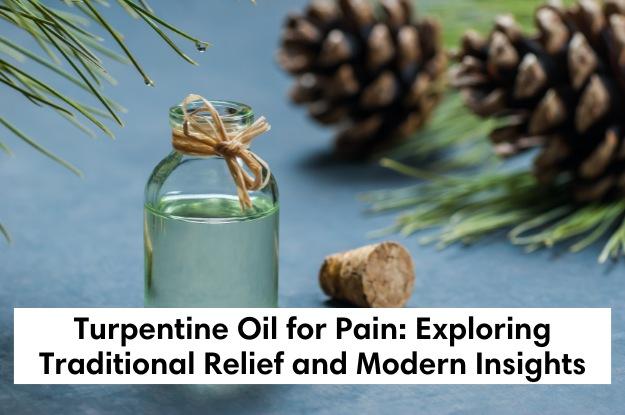Turpentine Oil for Pain: Exploring Traditional Relief and Modern Insights

Natural remedies have been used for generations to manage pain, and one such substance that continues to spark curiosity is turpentine oil. Extracted from pine tree resin, turpentine oil has a long history of use in traditional medicine, especially for relieving muscle and joint pain.
But what exactly is turpentine oil? Can it actually help with pain relief? And more importantly, how safe is it to use? In this article, we take a closer look at turpentine oil for pain, diving into its origins, uses, potential benefits, and safety considerations — all in a simple, reader-friendly way.
Traditional Uses of Turpentine Oil
Before the rise of modern pharmaceuticals, people turned to natural substances for healing. Turpentine oil has been used traditionally in various cultures as a remedy for:
-
Rheumatic pain
-
Muscle soreness
-
Chest congestion (when used in steam)
-
Skin conditions like minor cuts or fungal infections (when diluted)
In folk medicine, it was often mixed with other ingredients to create topical salves or liniments. While some of these practices may seem outdated today, they laid the groundwork for exploring turpentine’s properties further.
Benefits of Turpentine Oil for Pain Relief
One of the main reasons people still explore turpentine oil is because of its anti-inflammatory and counter-irritant effects. When applied topically (and properly diluted), it may stimulate blood flow to the affected area, which can help reduce pain and stiffness.
Here are some commonly discussed benefits of turpentine oil in relation to pain:
-
May ease joint discomfort linked to arthritis or overuse
-
Can support muscle relaxation after physical activity
-
Offers a warming effect that may soothe aches
-
Could assist with stiffness or limited mobility in minor injuries
It's important to note that while many people report relief, most of the evidence is anecdotal or based on traditional practices. Clinical research is still limited in this area.
Natural Remedies for Joint Pain: Where Does Turpentine Oil Fit?
When discussing natural remedies for joint pain, there’s no shortage of options: turmeric, ginger, Epsom salt soaks, and essential oils like eucalyptus or peppermint. Turpentine oil is sometimes added to this list, especially among those who prefer older, nature-based solutions.
Its warming properties may help increase circulation in stiff joints. However, it’s typically used in small amounts and often blended with carrier oils or wax-based balms to avoid irritation.
If you're interested in exploring natural alternatives, turpentine oil can be one piece of the puzzle — though it should be approached with care and balanced with other practices like gentle exercise, stretching, and a balanced diet.
Essential Oils for Muscle Pain: How Does Turpentine Compare?
Turpentine oil isn’t the only essential oil used for relieving sore muscles. In fact, essential oils for muscle pain often include:
-
Peppermint oil (cooling, numbing)
-
Lavender oil (calming, anti-inflammatory)
-
Eucalyptus oil (refreshing, anti-microbial)
-
Turpentine oil (warming, circulation-boosting)
What sets turpentine apart is its stronger aroma and more intense sensation, which is why it’s often used sparingly and always diluted. For those looking for a warming counterbalance to muscle aches, turpentine oil may offer a unique effect that others do not.
How to Use Turpentine Oil Safely
While turpentine oil has potential benefits, using it incorrectly can lead to skin irritation, allergic reactions, or other issues. Safety is key when working with potent natural substances.
Here are some general tips on how to use turpentine oil safely:
1. Always Dilute Before Applying to Skin
Turpentine oil should never be used undiluted. Mix it with a carrier oil like coconut, olive, or almond oil. A common ratio is 1–2 drops of turpentine oil per tablespoon of carrier oil.
2. Do a Patch Test
Before applying it widely, test a small amount on your forearm. Wait 24 hours to check for any reactions.
3. Avoid Broken Skin and Sensitive Areas
Do not apply turpentine oil to open wounds, rashes, or near the eyes or mucous membranes.
4. Inhalation Should Be Minimal
While some traditional remedies used it for steam inhalation, this is not widely recommended today due to the risk of irritation to the lungs.
5. Keep Out of Reach of Children
Even natural substances can be harmful in large doses or if accidentally ingested.
When to Be Cautious
Despite being natural, turpentine oil is a strong and active compound. Individuals with sensitive skin, allergies, or respiratory conditions should avoid using it without medical consultation.
It’s also not suitable for everyone:
-
Pregnant or breastfeeding women should avoid it.
-
People with skin disorders or asthma may be more sensitive to its effects.
If pain persists, worsens, or is accompanied by swelling or fever, it’s best to consult a healthcare provider rather than relying on home remedies alone.
Conclusion: Should You Consider Turpentine Oil for Pain?
Turpentine oil for pain relief is an age-old remedy that some still find helpful, especially when used with care and proper dilution. While modern medicine offers many solutions, it’s clear that traditional practices like this still hold interest for those seeking natural and alternative approaches.
Whether it’s used as part of a warm compress or in a homemade balm, turpentine oil may offer temporary comfort for joint and muscle discomfort — but like all remedies, it should be used thoughtfully and safely.
As with any approach to managing pain, balance is key: combine knowledge of traditional wisdom with modern awareness, and always listen to your body.
- Art
- Causes
- Crafts
- Dance
- Drinks
- Film
- Fitness
- Food
- Giochi
- Gardening
- Health
- Home
- Literature
- Musica
- Networking
- Altre informazioni
- Party
- Religion
- Shopping
- Sports
- Theater
- Wellness


